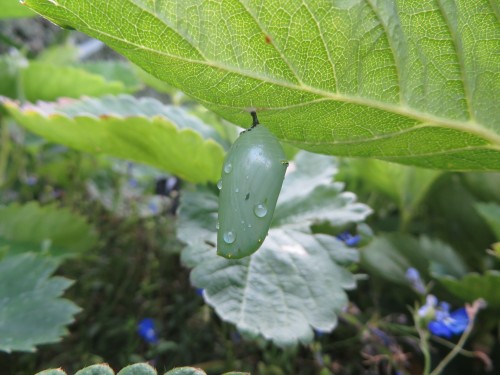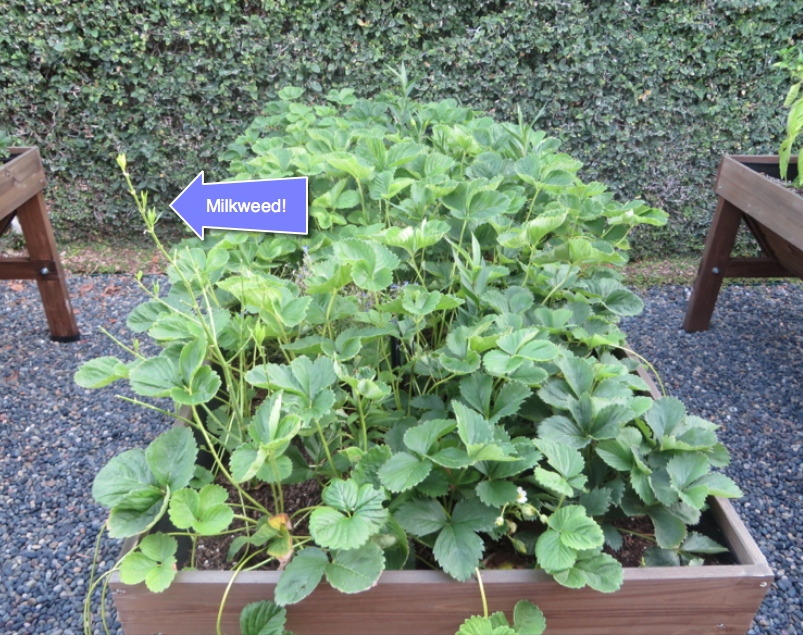I’m living vicariously through my friends who are now growing Milkweed.
My ecosystem should have produced one more generation of Monarch butterflies. But it hasn’t. Only one butterfly has visited in the last few months. It was a female and it did lay eggs, but I never saw a caterpillar. Two friends entrusted me with their caterpillars and the caterpillars disappeared in a matter of days. The word is out. My atrium has become a no butterfly zone.
Numerous predators and pathogens threaten Monarchs and at every stage of their life cycle – from egg to caterpillar to chrysalis to butterfly. Several known predators exist in my atrium today and as I read about the trials and tribulations of other butterfly enthusiasts I suspect there may be more not yet known to me.
If the transformation wasn’t so magical or the butterfly so beautiful, or if the Monarch hadn’t touched my life in unimaginable ways, I’d probably give up. But soon it will be time for Monarchs to migrate. So instead of giving up I will continue to learn from the butterfly community, re-assess and make a plan for next year.
But don’t despair about the state of my garden because where I have been struggling others have not. I have started a movement amongst my circle of friends. Others whom I have inspired to grow Milkweed are producing butterflies! My friend HMo is currently raising the Fearsome Five, as she likes to call them.
In three raised table-height beds HMo grows strawberries, a variety of peppers, zucchini, kale, butter lettuce, tomatoes and stargazer lilies (her favorite flower). There is one measly Milkweed plant stripped of its leaves in and amongst the strawberry plants. That plant fed 7 caterpillars and 5 of those are now nestled safely under the leaves of her strawberry plants as chrysalises.
More important than raising Monarchs is the joy they spread. MC and HMo read my blog. They have observed the various stages of the life cycle in my garden. But I don’t think they really understood the magic until they started growing Milkweed.
Someone once asked me why they should care about the Monarch. You certainly don’t have to care; Monarchs are not critical to your survival. They won’t put a roof over your head or food on your table. They won’t make you rich or even financially comfortable. Yet many cultures throughout history have placed importance on the butterfly. As the author Maraleen Manos-Jones writes in her book, The Spirit of Butterflies: Myth Magic, and Art, “We need butterflies to remind us that positive change is possible, that there is magic to life. Butterflies awaken our spirit and open our hearts. They give us a sense of hope and the possibility of our own transformation and evolution.”
I think MC and HMo would tell you that until witnessing the entire Monarch life cycle firsthand this was just something someone told them. Seeing it yourself is believing.
HMo drags her husband out to the garden every morning to see the changes. Look how big the peppers are today, was there a new squirrel attack on the tomatoes, see how the ladybugs eat the aphids on the Milkweed plants, are there any tomato Hornworms that need removing, help me find the Monarch caterpillars. He looks and listens dutifully, but she thinks he is only humoring her. That is until one day when he comes home and excitedly tells her about a new coffee house in town that has on its patio Milkweed plants full of butterflies.
So I raise my glass to the Fabulous Five, the final generation of 2014.
Photos: A Fabulous Five chrysalis and HMo’s strawberry garden




1 comment
Great photos! They’re still in the “green zone” so I didn’t miss them “coming out” on my weekend away… Extreme heat continues – maybe it’s cooler living as a chrysalis?